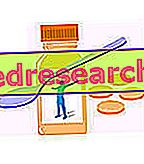See also: Escherichia coli in urine
Biology
Escherichia coli is a bacterium commonly found in the intestines of homoeothermic men and animals. Gram negative, asporiginal, aerobic - optional anaerobic, rod-shaped, Escherichia coli is a normal commensal of the colon; this means that it lives at the expense of the human organism without causing particular damages or benefits.
It feeds on sugars such as lactose and glucose, which ferments originating acids and gases, and contributes to the production of vitamin K. Due to this characteristic and to the ability to counteract intestinal colonization by pathogens, the innocuous strains of Escherichia coli can be even considered symbionts; this means that both they and the guest derive mutual benefit from living together.
Pathogenic strains
Some strains of Escherichia coli cause disease, generally limited to transient diarrheal episodes. The traveller's diarrhea, for example, is often caused by enterotoxigenic Escheria coli strains, which among children in developing countries represent the first cause of bacterial diarrhea.
| Escherichia coli strains associated with intestinal diseases | |
| Enterotoxic oxygen Escherichia coli | ETEC |
| Entreroinvasive Escherichia coli | EIEC |
| Enteropathogenic Escherichia coli | EPEC |
| Escherichia Coli enteroaderente | CEAA |
| E. coli producing verotoxins | VTEC |
| Enterohemorrhagic Escherichia coli | EHEC |
Incubation is short (12-72 hours) and diarrhea, frankly aqueous, is accompanied by abdominal cramps, sometimes vomiting, but normally has no mucus or blood.
It should also be noted that the same commensal strains (normally harmless) under certain conditions can cause illness outside the enteric tract. Favored by the weakening of the immune system, diabetes or the presence of a calculus or a urinary catheter, these bacteria can for example go up the urinary tract and produce annoying urethritis, cystitis, prostatitis and in more serious cases pyelonephritis. Other extraintestinal pathogenic strains can cause neonatal meningitis, septicemia, peritonitis and infections of other internal organs.

Enterohemorrhagic strains
Some strains of Escherichia coli have a high pathogenicity. It is the case, for example, of the fearsome "Escherichia coli O157: H7", progenitor of the so-called enterohemorrhagic strains. These bacteria, as the "enterohemorrhagic" attribute suggests, cause an infection characterized by symptoms such as bloody diarrhea, severe abdominal cramps and possible extraintestinal complications, even serious ones.
The various serotypes of Escherichia coli belonging to this group produce rather aggressive toxins, similar to those generated by Shighella dysenteriaee, which damage the intestinal mucosa and can cause cases of hemolytic uremic syndrome (HUS or SEU), which occurs in about 5% of cases (especially among children and the elderly).
Contagion
The adult may come into contact with pathogenic Escherichia coli strains by ingesting water or contaminated food, especially fresh vegetables and ground beef that is not properly cooked. Burgers, salamis, raw milk (unpasteurized), vegetables (especially lettuce and sprouts) and unpasteurized fruit juices are other typical food at risk. Direct human-to-human transmission is also possible from excretory animals per person.
Beef minced is a food particularly at risk for various reasons. In fact, these animals represent the main reservoir of Escherichia coli O157, which during the slaughter and subsequent grinding can pass from the intestines to the meat, nesting inside where they are more protected from the cooking heat than those on the surface.
Prevention
- Wash your hands thoroughly, especially before touching the food in preparation, after coming into contact with animals and especially with their feces.
- Wash hands thoroughly after touching raw meat or going to the toilet.
- Minced meat and minced meat products must be cooked at a minimum internal temperature of 70 ° C for 2 minutes. It must be ensured, in particular, that even the most internal layers of meat lose the typical pink color of raw meat.
- Avoid cross-contamination between infected foods, keeping raw meat separate from cooked ones and thoroughly washing all utensils used to handle raw food. Use separate chopping boards for meat and other foods.
- Carefully wash the vegetables with drinking water before consumption, especially if they are of the type that is not peeled or cooked.
The infection can also be contracted by swimming in contaminated water (due to the accidental ingestion of the liquid).
Symptoms
After the infection, the first symptoms appear on average within 12-60 hours, even if incubation periods of 3-5 days have been reported. The infection initially manifests itself as light, non-haemorrhagic diarrhea, which can be accompanied by abdominal pain and a transient febrile rise. During 24-48 hours the diarrhea increases in intensity and is maintained for 4-10 days, during which it is often mixed with blood and accompanied by severe abdominal pain and modest dehydration; fever is normally absent.
Hemolytic uremic syndrome
Hemolytic uremic syndrome (HUS) is a complication of Escherichia coli O157: H7 infections. It is a very serious form of renal failure, more common in the very young and the elderly, which in a small percentage of cases can lead to death despite intensive therapy (about 50% of these patients require dialysis).
Characteristic signs of this condition, which may occur a week after the onset of gastrointestinal symptoms, are edema (diffuse swelling) and acute renal failure. For more information, read: Symptoms Hemolytic-uremic syndrome.
Normally, however, the infection sustained by Escherichia coli O157: H7 or other enteroemmoragic serotypes resolves spontaneously without resorting to particular drugs. In uncomplicated cases, the latest guidelines only recommend rest combined with a generous intake of liquids to replace water and salt losses. The return to normal nutrition should be gradual, starting with foods low in fiber, such as crackers, rice, toast and other dry cereals; in this phase foods rich in fat or fiber, dairy products and seasoned products will be limited, which will then be reintroduced gradually into the diet.
Escherichia coli - Video: Causes Symptoms Diagnosis Cures
X Problems with video playback? Reload from YouTube Go to Video Page Go to Wellness Destination Watch the video on youtube



